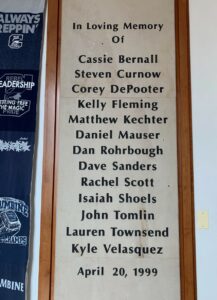On April 20, 1999, Columbine High School was hit with tragedy, chaos, and carnage when two seniors attacked.
While the two students had initially planned a multi-stage attack that involved multiple rounds of bombing and shooting, the bombs, fortunately, did not detonate as planned.
Unfortunately, the two attackers didn’t stop their plan altogether, instead decided to go through the school and open fire at students and teachers. After 49 minutes, the massacre was over. In total, 12 students and one teacher had been murdered. The two shooters were also dead at their own hands.
This Saturday marks 25 years since the shooting. That is a quarter of a century. In that time, dozens of stories and cultural narratives have sprung up around the massacre. Many, I would even venture to say most, of these are fake or at least lacking context.
The issue of gun violence has been rightfully brought up constantly in conversations about Columbine. It’s a worthy issue, especially since nearly 400 school shootings have occurred in the two and half decades since the attack, but it’s been talked about so much that I am more interested in another issue. I want to explore a little about how the media mishandled the case.
Some of the most pervasive and long-lasting narratives around the massacre come from interviews given by surviving students in the immediate aftermath of the attack. Stories of potential motives and the behaviors of the shooters were broadcast and published nationally, without any kind of routine fact-checking that is usually done to claims, as there was a rush to get stories out quickly.
Students interviewed outside of the school as soon as the massacre had ended were all in states of shock or distress, and in the hysteria, they gave information that was later confirmed to be false, though since the information was included in the first stories to be published about the case, it’s what most people continue to believe.
As both shooters were dead, ideas of their motives began being speculated. The most common narrative is that the shooting was revenge for bullying or that the shooters’ bullies were targeted in the attack.
This is not true, as the initial plan, that thankfully ended up failing, was to blow up the school. This was meant to be a totally indiscriminate attack with the goal of killing everyone in the school.
There is some evidence that the pair of shooters were bullied and while that did contribute to their anger at the world more broadly, their taste for violence was more general. There’s no evidence that the shooters tried to hunt down specific people, seemingly letting people live or killing them on a whim, not for any specific rhyme or reason.
In fact, several survivors report the shooters engaging in bullying behaviors like taunting both people they shot and those that they didn’t. They would go after whatever they could, skin color, religion, wearing glasses, anything.
Similarly, accounts of the shooters as loners and outcasts are also inaccurate. While their writings indicate that they felt misunderstood or unheard in some capacity, they each did have close groups of friends, as well as hobbies.
There was also a lot said about the shooters being in the group at the high school called the “Trench Coat Mafia.” The majority of the students in this group of friends had already graduated by the time of the massacre and though the shooters knew some of the people in the Trench Coat Mafia, they were not close with any of them.
These are the most commonly known false or inaccurate narratives around Columbine, but my least favorite thing about media coverage of the massacre is how prominently the shooters’ faces and names are displayed. Every article, magazine, documentary, and movie about the events is constantly making the shooters the main focus of things, which has been linked to causing a contagion effect, leading to more similar attacks.
The victims are the ones worthy of memory, not the shooters, which is why I have taken care to not restate their names here. What I will restate here are the far less-known names of the victims.
Cassie Bernall, Steven Curnow, Corey DePooter, Kelly Fleming, Matthew Kechter, Daniel Mauser, Daniel Rohrbough, Dave Sanders, Rachel Scott, Isaiah Shoels, John Tomlin, Lauren Townsend, Kyle Velasquez.
These are the names of 13 people who should be 25 years older this year, people who deserved to live and had their lives taken away from them in a senseless act of violence by two people whose names are more frequently remembered by the broader culture than their own.
So, if you take anything away from this piece, please remember their names and give them and their families a thought this Saturday.
For comments/questions about this story DM us on Instagram @thewhitatrowan or email thewhit.opinion@gmail.com






